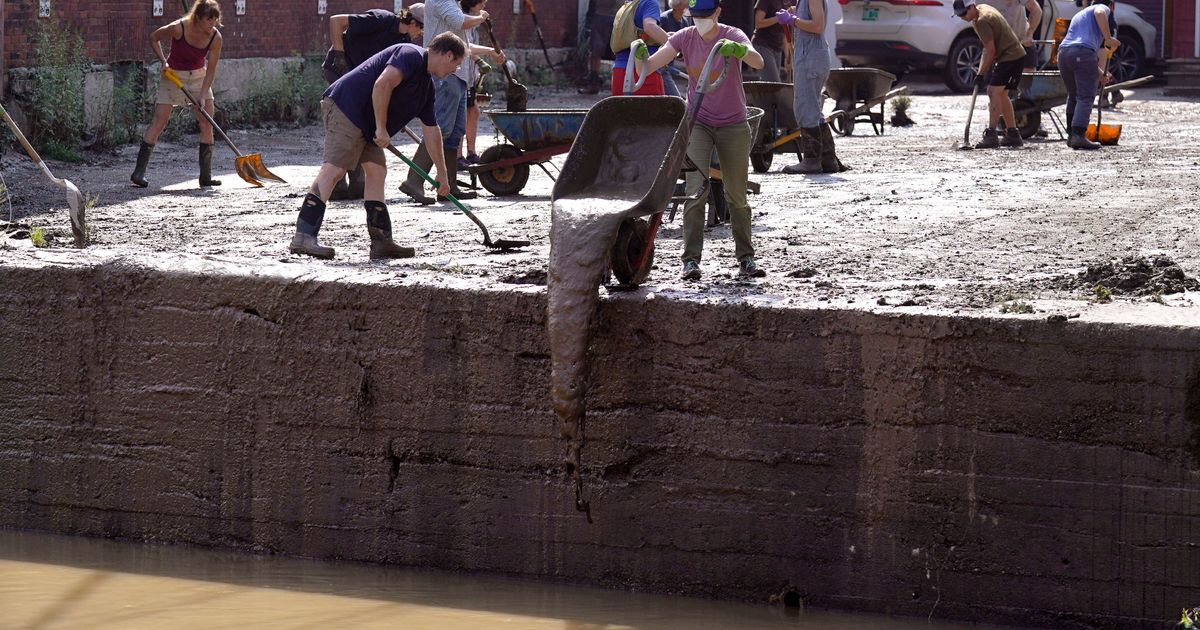The Marshfield Village Store, located at the intersection of two rural highways in a quaint Vermont town, has transformed into a multifunctional hub amidst the aftermath of devastating floods that have affected the state. Initially serving as a shelter for approximately thirty-six individuals, the store has now transitioned into a distribution center for essential resources such as fresh water and supplies. Michelle Eddleman McCormick, the store’s general manager, explained that they are preparing to extend their assistance formally to individuals who have not yet received the support they require. Their aim is to provide equipment, volunteers, emergency medication, and aid in property restoration.
Recent storms in the region have resulted in rainfall equivalent to two months’ worth in just a few days, surpassing the levels experienced during the destructive Tropical Storm Irene in 2011. This unprecedented flooding event has been declared the worst natural disaster in Vermont since the floods of 1927, leading some officials to attribute these extreme weather events to the impacts of climate change. The state is anticipating more rainfall in the upcoming days, posing a potential risk for landslides.
Tragically, one individual has lost their life due to the flooding. Stephen Davoll, aged 63, drowned in his home in Barre, a central Vermont city. Vermont Emergency Management has urged residents to exercise caution as they return to their homes for repairs and to be aware of potential hazards. U.S. Senator Peter Welch expressed his condolences and acknowledged the pain Vermont experiences from the loss of its residents.
President Joe Biden has granted the major disaster declaration requested by Vermont Governor Phil Scott, allowing federal aid to be provided. Governor Scott has also sought assistance from the U.S. Department of Agriculture to declare a disaster due to the significant damage inflicted on crops. Farms have been severely affected, following a previous challenging frost event in May. The destruction of crops and livestock feed is anticipated to be substantial, especially since much of the state’s fertile farmland is located in river valleys that have been inundated.
Assessors from the Federal Emergency Management Agency are scheduled to commence inspections in heavily affected areas of Vermont to determine eligibility for government assistance. U.S. Transportation Secretary Pete Buttigieg is also expected to visit the state next week to assess the extent of the flood damage. Furthermore, Vermont, as well as neighboring states like New Hampshire and Maine, are bracing for additional rainfall in the upcoming week. Monitoring agencies are keeping a close eye on water levels across the region.
Efforts are underway to establish contact with communities that have not yet reached out to Vermont emergency management officials. National Guard troops have been dispatched to facilitate communication. The state has announced the opening of centers in Barre and Ludlow to assist flood survivors in their recovery. Most emergency shelters have been emptied, with fewer than seventy individuals remaining. The main focus now is on providing food, water, and infrastructure repairs, including the reopening of numerous closed roads. It is estimated that twenty-three water treatment plants were either flooded or discharged untreated sewage into waterways.
In Ludlow, residents have largely returned to their homes, with restored electricity and water services. However, challenges persist. The post office and wastewater treatment plant have sustained extensive damage, and several restaurants and the primary grocery store have closed due to flooding. Nonetheless, the community has come together to establish makeshift pantries to provide fresh meals, while the community center serves as a central hub for donated water, food, and medicine.
Volunteer response has been significant, with approximately 5,200 individuals registering through the state emergency management agency and an online recruitment platform called SerVermont. However, it is acknowledged that many other volunteers have organized through local organizations, towns, and informal networks, and these efforts are encouraged as they often address critical needs more promptly. Volunteers are assisting in various capacities, from driving for charities such as Meals on Wheels to providing transportation to medical appointments and participating in general cleanup.
As additional rain is anticipated, it is imperative that residents abide by safety guidelines as they recover from the storm. Miro Weinberger, the mayor of Burlington, Vermont’s largest city, emphasizes the ongoing state of emergency and urges residents to follow road closures and directives from state and local officials. Individuals are advised to stay away from river banks, brooks, and streams, as flash floods can occur swiftly.
Michelle Eddleman McCormick contributed to this report from Concord, New Hampshire, and Michael Whittle contributed from Portland, Maine. Associated Press reporters Lisa Rathke in Marshfield and Michael Casey in Boston also provided valuable information.
Denial of responsibility! VigourTimes is an automatic aggregator of Global media. In each content, the hyperlink to the primary source is specified. All trademarks belong to their rightful owners, and all materials to their authors. For any complaint, please reach us at – [email protected]. We will take necessary action within 24 hours.


